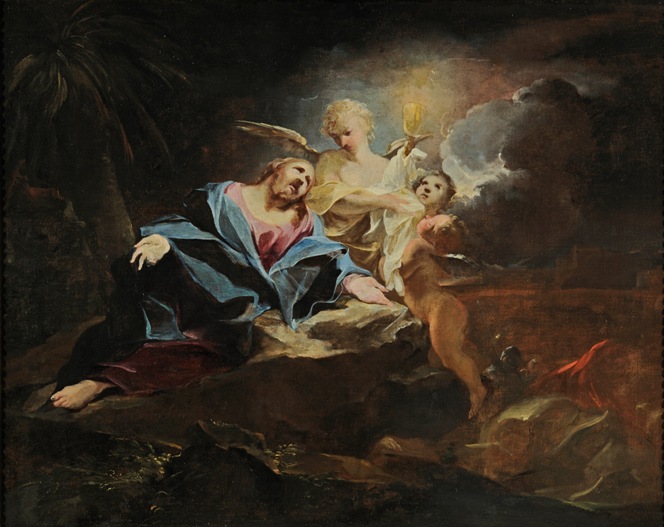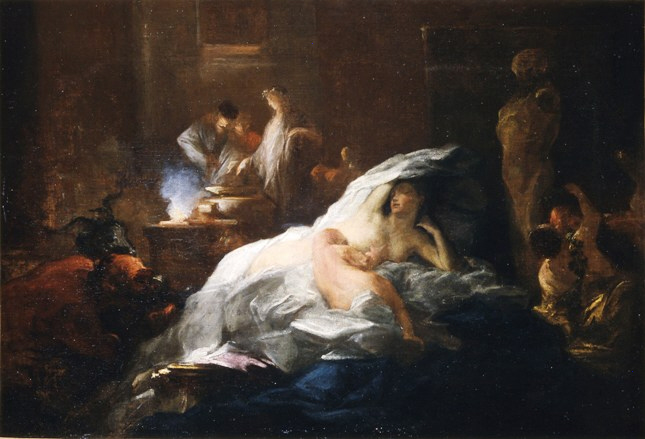 |
| Louis Cretey (1635-1702), The Vision of St Jerome Musée des Beaux-Arts, Lyon |
Fine Arts Museum, Lyon
22nd October 2010 to 24th January 2011
Curators:
Pierre Rosenberg of the Académie Française and Honorary Director-President of the Louvre Museum
Aude Henry-Gobet, Dr in Art History
Following the restoration of the frescoes in the refectory of St Peter's Abbey in Lyon, the museum is devoting this large exhibition to the great seventeenth century painter Louis Cretey. More than sixty paintings and drawings, mostly from private collections but also from French and foreign institutions celebrate the work of the artist. His poetic and expressive style, delicate and at the same time profoundly dramatic, makes him a visionary painter, a true precursor of modern art.
The exhibition is accompanied by a catalogue edited by Pierre Rosenberg of the Académie Française, a specialist in seventeenth and eighteenth century French art.
.jpg) |
| Louis Cretey, St Augustine and the Infant Christ Church of St Augustine, Lyon |
Fine Arts Museum, Lyon website
Presentation of the Exhibition (in French)
Report on the restoraton of the paintings in the Abbey of St-Pierre, Lyon by France3 TV:
Aude Henry-Gobet on the trail of Louis Cretey:
Exhibition curator Pierre Rosenberg on French radio:
Louis Cretey, a 17th century Master emerges from oblivion: two art historians reconstruct the life and work of a great painter from Lyon.
(review by Eric Bietry-Rivierre in Le Figaro)The history of art sometimes mixes with the detective genre. Witness the beautiful enigma that Pierre Rosenberg of the Académie Française and former head of the Louvre, and Aude Henry-Gobet, a young researcher who studied at the Villa Medici, are poised to solve. Together they have studied the case of Louis Cretey, a mysterious and poorly-known seventeenth century French painter.
Until now he was known only by a handful of passionate collectors. Cretey appears dotted around museums in Detroit, Stockholm, at the Palazzo Barberini in Rome, the Vatican and the Louvre. Some scholars in Lyon also knew that the ancient capital of Gaul contained the frescoes in the refectory at the Benedictine Abbey of Saint-Pierre, now transferred to the entrance hall of the Museum of Fine Arts (recently restored by the BNP Paribas Foundation), and those in the former courthouse. Otherwise, there remain only three letters by Cretey, dated and signed. Not enough physical evidence to reconstruct a life and career...
 |
| Louis Cretey, Christ in the Garden of Olives Musée des Beaux-Arts, Lyon |
In any event, unlike the seventeenth century mainstream, Cretey's painting is neither polished nor precious. Even if the attitudes or the expressions of his saints and heroes are delicate, the hand that paints them is brutal. On the surface, Cretey lets himself be transported and makes his improvisation apparent. He loves incompletion. Another unique feature: a decided love of the bizarre, "to the point that one imagines a Fuseli or a Goya before their time," remarks Rosenberg.
Cretey is thus neither classical nor academic. As he was outside the artistic circles of Paris and Versailles, he was too soon regarded as simply provincial. But now, in Grand Siècle aesthetics, between Le Brun and Watteau, he is renowned as a meteor. Which is nice even if it hardly compares with the rediscovery of the Le Nain brothers or Georges de La Tour in the nineteenth and twentieth centuries.
 |
| Louis Cretey, Scene from Antiquity Musée des Beaux-Arts, Lyon |
"The exhibition will open a debate, either confirming or denying what we conceive as still a proposal," warns Aude Henry-Gobet. Fifteen experts will soon also assess the works. They will also decide on the question of detailed chronology, as the art historian has displayed the works in an order of production resulting from meticulous research carried out in various archives.
 |
| The refectory of the Benedictine Abbey of St Pierre, Lyon after restoration |
(translation: A Curran)

I just visited the show at Musée des Beaux Arts and was a bit disappointed, not by Louis Cretey but by the official commentaries, typically coming from people who never practiced painting and who are more interesting in blowing the horn for themselves that by the artist. They pretend to have rediscovered Louis Cretey 20 years ago: How come they never buy for their own museum a Louis Cretey Works? At least two important points are almost never mentioned: how the painting technics of Louis Cretey is original and different from the one used by the painters of the second half of the 17th c. and what makes Louis Cretey a real Lyonnais painter, not by his birth but by his style.
ReplyDelete